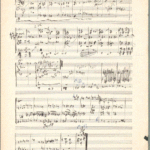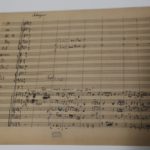
- Year 1909.
- 02-09-1909 Toblach: Completes draft orchestral score of Symphony No. 9.
- None.
- Duration:
- Movement 1: Andante comodo 31.00 ...

The first movement embraces a loose sonata form. The key areas provide a continuation of the tonal juxtaposition displayed in earlier works (notably the Symphonies No. 6 and No. 7). The work opens with a hesitant, syncopated rhythmic motif (which Leonard Bernstein (1918-1990) suggested is a depiction of Mahler's ...

The second movement is a series of dances, and opens with a rustic Ländler, which becomes distorted to the point that it no longer resembles a dance. It contains shades Mahler's Symphony no.4, Movement 2: In gemächlicher Bewegung, in the distortion of a traditional dance into a bitter and ...

The third movement, in the form of a rondo, displays the final maturation of Mahler's contrapuntal skills. It opens with a dissonant theme in the trumpet which is treated in the form of a double fugue. The following five-note motif introduced by strings in unison recalls of Symphony No ...

The final movement, marked zurückhaltend ("very slowly and held back"; literally, "reservedly"), opens with only strings. Commentators have noted the similarity of the opening theme in particular to the hymn tune Eventide (Abide With Me is a well-known Christian hymn composed by Henry Francis Lyte in 1847).
...
Woodwind
- 1 Bass clarinet Bb.
- 4 Bassoon. Solo in Movement 3: Rondo-Burleske: Allegro assai. Sehr trotzig.
- 3 Clarinet A.
- 3 Clarinet Bb.
- 1 Clarinet Eb.
- 1 Contra bassoon. Solo in Movement 4: Adagio. Sehr langsam und noch zuruckhaltend.
- 1 Cor Anglais (English horn).
- 4 Flute.
- 4 Oboe.
- 1 Piccolo.
Brass
- ...

